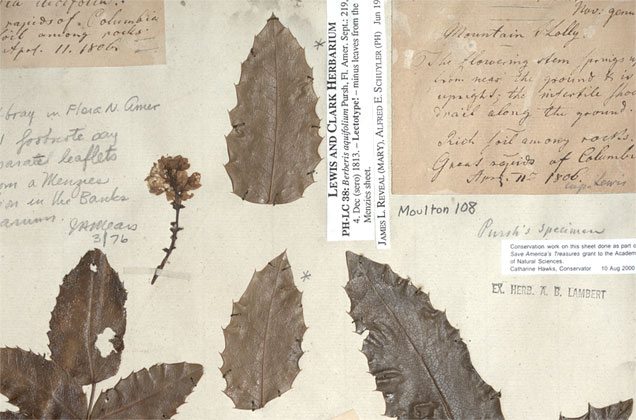Lewis and Clark Herbarium

Meriwether Lewis and William Clark are most famous for traversing America’s western territories on foot and horseback during the Corps of Discovery Expedition (1804–06). The primary goal of that trip was to gather and record scientific information about western animals, plants, and geography. The explorers filled journals with observations of new species and landscapes, and they returned with a wide variety of specimens, including many newly discovered plants. The Academy houses almost all the remaining plants collected by members of the expedition.
The nearly complete Lewis and Clark plant collection has not always been housed in Philadelphia as it is now. Following the expedition, Lewis sent plants to Thomas Jefferson in Washington, who then passed them on to the American Philosophical Society in Philadelphia. In 1811, Philadelphia botanist Benjamin Smith Barton and the German botanist Fredrick Pursh began to describe the Lewis and Clark collection, but Pursh took several of the specimens when he left for England later the same year. Two years later, he published descriptions of the collection in a book on North American plants.
As time went on, the collection was stored, mostly unused, at the American Philosophical Society. Pursh’s plants ended up in the collection of British botanist Aylmer Lambert, and they were sold to Academy member Edward Tuckerman at an auction when Lambert died in 1842. Tuckerman donated them to the Academy in 1856. In 1897, Academy botanist Thomas Meehan recognized Tuckerman’s donations as part of Lewis’ collection. He found the rest of the collection, still bundled by Lewis, in the Philosophical Society’s attic. Through Meehan’s initiative, the collection was reassembled and housed at the Academy, where it remains today with all but 10 sheets that are still in England. The collection was rehoused in 1999 through a grant from Save America’s Treasures, a National Trust for Historic Preservation program that restored nationally significant historic sites and special collections across the country.
 The BC (Biocultural) Notice is a visible notification that there are accompanying cultural rights and responsibilities that need further attention for any future sharing and use of this material or data. The BC Notice recognizes the rights of Indigenous peoples to permission the use of information, collections, data and digital sequence information (DSI) generated from the biodiversity or genetic resources associated with traditional lands, waters, and territories. The BC Notice may indicate that BC Labels are in development and their implementation is being negotiated. For more information about the BC Notice click here.
The BC (Biocultural) Notice is a visible notification that there are accompanying cultural rights and responsibilities that need further attention for any future sharing and use of this material or data. The BC Notice recognizes the rights of Indigenous peoples to permission the use of information, collections, data and digital sequence information (DSI) generated from the biodiversity or genetic resources associated with traditional lands, waters, and territories. The BC Notice may indicate that BC Labels are in development and their implementation is being negotiated. For more information about the BC Notice click here.